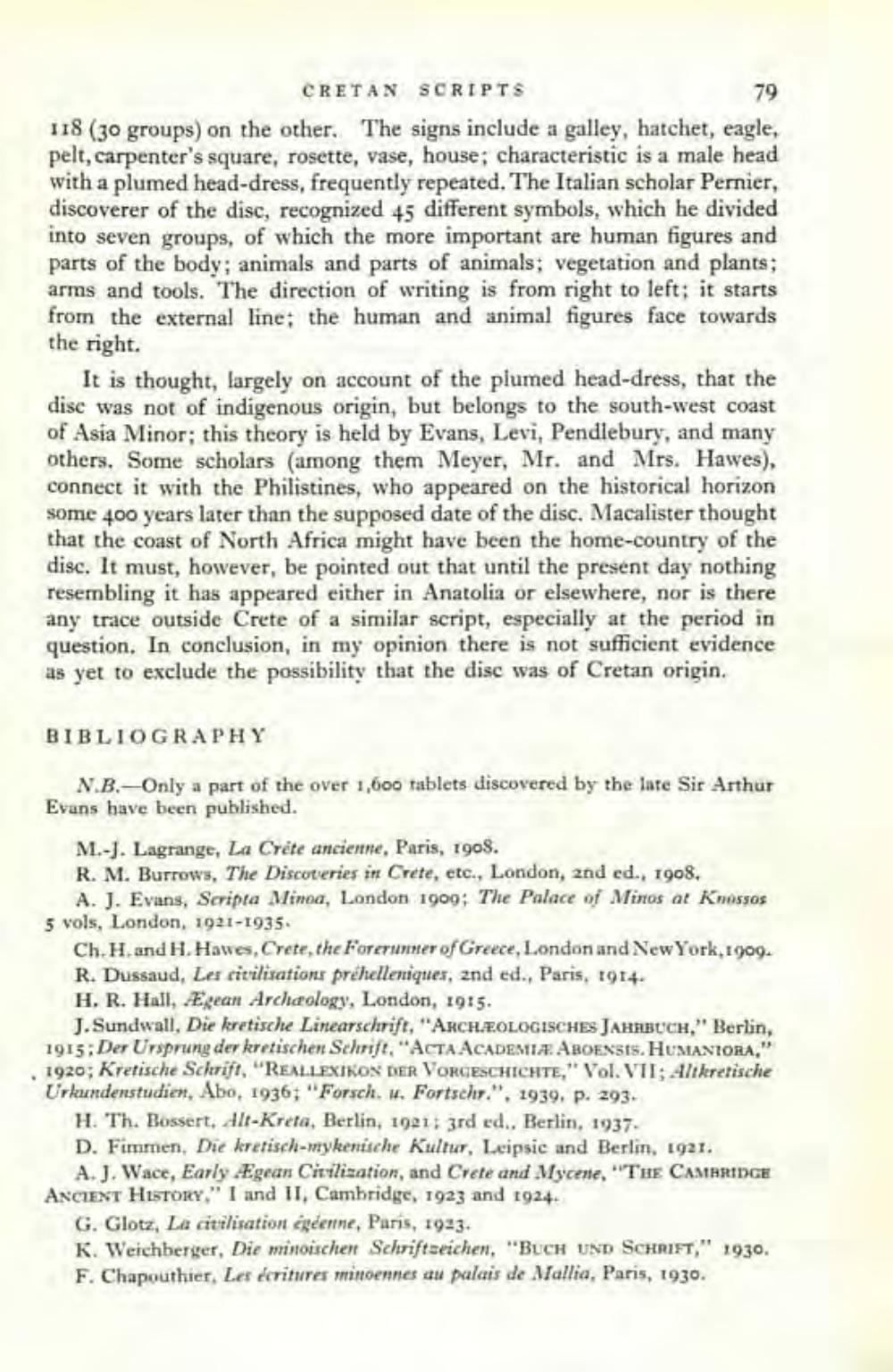________________
CRETAN SCRIPTS
79 118 (30 groups) on the other. The signs include a galley, hatchet, eagle, pelt, carpenter's square, rosette, vase, house; characteristic is a male head with a plumed head-dress, frequently repeated. The Italian scholar Pernier, discoverer of the disc, recognized 45 different symbols, which he divided into seven groups, of which the more important are human figures and parts of the body; animals and parts of animals; vegetation and plants; arms and tools. The direction of writing is from right to left; it starts from the external line; the human and animal figures face towards the right.
It is thought, largely on account of the plumed head-dress, that the dise was not of indigenous origin, but belongs to the south-west coast of Asia Minor; this theory is held by Evans, Levi, Pendlebury, and many others. Some scholars among them Meyer, Mr. and Mrs. Hawes), connect it with the Philistines, who appeared on the historical horizon some 400 years later than the supposed date of the disc. Macalister thought that the coast of North Africa might have been the home-country of the disc. It must, however, be pointed out that until the present day nothing resembling it has appeared either in Anatolia or elsewhere, nor is there any trace outside Crete of a similar script, especially at the period in question. In conclusion, in my opinion there is not sufficient evidence as yet to exclude the possibility that the disc was of Cretan origin.
BIBLIOGRAPHY
N.B.-Only a part of the over 1,600 tablets discovered by the lare Sir Arthur Evans have been published.
M.-J. Lagrange, La Crète ancienne, Paris, 1908. R. M. Burrows, The Discoveries in Crete, etc., London, 2nd ed., 1908.
A. J. Evans, Scripta Minoa, London 1909; The Palace of Minos at Knossos 5 vols, London, 1921-1935
Ch. H. and H. Hawes, Crete, the Forerunner of Greece, London and New York, 1909. R. Dussaud, Le civilisations préhelleniques, and ed., Paris, 1914. H. R. Hall, Ægean Archaology, London, 1915.
J. Sundwall, Die kretische Linearschrift, ARCHÆOLOGISCHES JAHRBUCH, Berlin, 1915: Der Ursprung der kretischen Schrit, "ACTA ACADEMIA ABOENSES. HUMANIORA." 1920; Kretische Schrift, "REALLEXIKON DER VORGESCHICHTE," Vol. VII; Alikretische Urkundenstudien, Abo, 1936; "Forsch. . Fortschr.". 1939, p. 293.
H. Th. Bossert, Al-Kreta, Berlin, 1921, 3rd ed., Berlin, 1937 D. Fimmen. Die kretisch-mykenische Kultur, Leipsic and Berlin, 1921.
A.J. Wace, Early Egean Civilization, and Crete and Mycene, "THE CAMBRIDGE ANCIENT HISTORY," I and II, Cambridge, 1923 and 1924.
G. Glotz, La civilisation égéenne, Paris, 1923. K. Weichberger, Die minoischen Schriftzeichen, "BUCH UND SCHRIFT," 1930. F. Chapouthier, Les critures minoennes au palais de Mallia, Paris, 1930.




